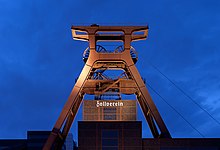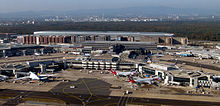High Low
| Hochtief Aktiengesellschaft
|
|
|---|---|
| legal form | Corporation |
| ISIN | DE0006070006 |
| founding | 1873 |
| Seat |
Essen , Germany |
| management |
|
| Number of employees | 55,777 (2018) |
| sales | 23.8 billion euros (2018) |
| Branch | Construction company |
| Website | www.hochtief.de |
The Hochtief Aktiengesellschaft (proper spelling: HOCHTIEF Aktiengesellschaft ) is a listed German construction company based in Essen . With a foreign share of total sales of 95%, the company is one of the largest international construction groups. In Australia, the group is market leader with its listed subsidiary Cimic . In the USA, Hochtief is a leader in commercial building construction through its subsidiary Turner and, with its US subsidiary Flatiron, is one of the most important providers in the transportation infrastructure sector . The group has been majority owned by the Spanish ACS Group since 2011 , with a stake of 50.40 percent (as of July 2019).
Products and services
Hochtief implements infrastructure projects around the world , partly on the basis of concession models and public-private partnerships . The core competence of the company is building. In 2013, the company moved away from the idea of mapping the entire value chain, consisting of planning, financing, building and operating and is now concentrating on the construction of transport and energy infrastructure as well as social / urban infrastructure and the mining business.
Urban and social infrastructure
The company develops and builds neighborhoods and districts that include residential properties and care properties with shops, offices and leisure facilities. Hochtief continues to build pure office properties, commercial and industrial properties, event properties, shopping centers and hotels . In the area of social infrastructure, the company builds and operates administration buildings , schools , universities , barracks , museums and town halls in Europe, Canada and the USA in public-private partnership programs .
Energy infrastructure
Hochtief is involved in the field of regenerative energies : As a construction group and infrastructure provider, the company offers services from generation and distribution to the efficient use of energy. Hochtief brings technical know-how and years of experience to complex infrastructure projects . The construction group is also active in the construction of tunnels and power plants .
The US subsidiary Flatiron Construction Corp is a specialist in overhead lines. The Australian Hochtief subsidiary Cimic also has many years of experience in offshore, energy infrastructure and plant construction.
Hochtief successfully completed the sale of the offshore assets to GeoSea, a subsidiary of the DEME Group, in May 2015.
Transport infrastructure
In the field of transport infrastructure, the company builds bridges , railways and train stations , airports and ports , roads , tunnels and motorways at home and abroad, partly as part of concession models such as public-private partnerships.
Mining business
Hochtief is active in the mining business through the Cimic Group , the largest contract miner in the world. Contract mining is the taking over and execution of work on a mine on behalf of the mine owner. This can include the planning and establishment of the mine, the dismantling and transport of raw materials , the operation of the mine including technical services on equipment, the construction of the necessary traffic routes as well as the final dismantling and renaturation .
history
Foundation and advancement
In 1873 the brothers Philipp Helfmann ( bricklayer ) and Balthasar Helfmann ( locksmith ) from Kelsterbach founded the Helfmann brothers company in Frankfurt am Main . Five years later, in 1878, the Helfmann brothers received their first major contract, the construction of the University of Giessen . After Balthasar's death, Philipp Helfmann converted the company into a public limited company for civil engineering in 1896. In 1922 the company headquarters was relocated to Essen . The background to this change was a contract dated February 10, 1921 with Hugo Stinnes . Stinnes took a stake in Hochtief and, in return, undertook to have the Stinnes Group's construction work carried out only through Hochtief. After Stinnes' death in 1924 and the collapse of his group, Hochtief also ran into financial difficulties. The hyperinflation also had a very negative impact on the construction industry. The Hochtief shares of the Stinnes concern have now been taken over by RWE and AEG .
Hochtief in the time of National Socialism
From 1933 onwards, Hochtief was also involved in the structures of National Socialism . The chairman of the board, Eugen Vögler , joined the NSDAP in 1937 and acted as leader of the construction business group and honorary ban leader of the Hitler Youth . The group itself fired all Jews on the supervisory board or in other responsible positions until 1935.
As a construction company, Hochtief benefited from the economic recovery and extensive construction contracts from the state. This initially included civil objects such as the expansion of the Reichsautobahn , the congress hall and the German stadium on the Nazi party rally grounds in Nuremberg. From 1937 Hochtief worked under the direction of the Todt Organization in the construction of the West Wall and in the following years participated in the construction of the Führerbunker and essential military facilities. From 1939/1940 onwards, Hochtief employed an increasing number of forced laborers on the construction sites .
According to its own statement, the group self-critically researched its corporate history during the National Socialist era and published it in a book in 2000.
Reconstruction and Modern History
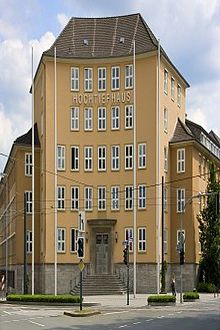
1945–1966
After the collapse in 1945, Hochtief had not only lost business abroad, but also its East German branches. The work was continued under the direction of the new chairman of the board, Artur Konrad. The economic miracle began with the reconstruction of Germany, from which the construction industry benefited particularly due to the severe destruction. After the currency reform in 1948, the "economic boom" began for Hochtief. The rebuilding of international business began as early as the early 1950s. The first foreign orders after the Second World War included a number of energy infrastructure constructions in Turkey, bridges and steel works in Egypt. In 1951/1952, Hochtief built the Mansourah Nile Bridge in Egypt as the first foreign project after the Second World War . The construction of the Sariyar hydropower plant began in 1952 and the Izmir power station in 1953. In 1954, Hochtief took part in a port construction company in Kandla , India. The company achieved great international fame through the relocation of the rock temple at Abu Simbel (November 1963 to September 1968, planning by Walter Jurecka , previously head of the foreign department and at the time on leave from the Vienna University of Technology) and the Mandulis temple at Kalabsha (1961 to 1963 ). These UNESCO - World Heritage had to because of the construction of the Aswan Dam be moved.
1967-1989
The company's focus has now shifted from pure construction services to turnkey construction and services, such as the Hilton Hotel in Athens . Foreign business was only to make up a small part of the business area until the mid-1970s. At this time, most of the orders came from within Germany, driven by the economic upturn. One of the company's main focuses was power plant construction. This included the construction of the Kahl nuclear power plant near Großwelzheim , a district of the Lower Franconian municipality of Karlstein am Main in Bavaria . The nuclear power plant with boiling water reactor was the first commercial nuclear power plant in the Federal Republic of Germany. The nuclear power plant was commissioned by RWE and Bayernwerk ; the plant was built by Allgemeine Elektricitäts-Gesellschaft (AEG) with General Electric as licensor and supplier for the boiling water reactor. The power plant went into operation on November 13, 1960 and on June 17, 1961, electricity was fed into the public grid for the first time. The company also implemented transport infrastructure projects in the 1960s and 1970s. Examples are the Túnel subfluvial Raúl Uranga in Argentina, the New Elbe Tunnel in Hamburg or the Bosporus Bridge in Istanbul.
After the 1973 oil crisis , the company benefited from the unexpected wealth of the oil-exporting countries and Hochtief realized the largest order in its history to date, the turnkey construction of King Abdulaziz International Airport , Saudi Arabia's largest airport in Jeddah . As a result, foreign business contributed more than half of the construction output for the first time in 1980 before it collapsed. The company could only be kept stable by expanding domestic business. This can also be seen in the major projects implemented in the 1980s.
1990-2007
After reunification , the group benefited from the construction boom, but from 1993 onwards, with the weakening economy, it was exposed to increased competitive pressure. At that time, the company introduced a new strategy under the leadership of initially Hans-Peter Keitel , later Herbert Lütkestratkötter: covering the entire value chain: "Planning, financing, building and operating". Corresponding acquisitions were made and new business areas were opened. In order to serve these business areas, the company founded new companies:
- 1991 - project development
- 1996 - facility management
- 1997 - Airport management
- 2002 - Infrastructure development and financing
In addition, the company expanded through international acquisitions:
- 2000 - Turner Corporation , USA (100 percent)
- 2001 - Leighton Holdings , Australia
In 2004, Hochtief changed from a subsidiary to a public company : through the sale of the shares from the majority shareholder RWE, Hochtief received a new international shareholder structure. The free float at the end of the 2004 financial year was over 80%. With the acquisition of the service companies Siemens Gebäudemanagement and Lufthansa Gebäudemanagement in 2004, the subsidiary Hochtief Facility Management expanded from 800 employees to approx. 4,500 employees. In 2007 the civil engineering company Flatiron, a leading provider of infrastructure projects in the USA, was acquired. The company also gained a foothold in the Gulf region: for several years it has been represented in the Gulf States by the Habtoor Leighton Group, a subsidiary of Leighton.
Loss of independence
At the beginning of 2006 August von Finck acquired a stake of 25.01% with his Custodia Holding. In March 2007, the Spanish construction group Actividades de Construcción y Servicios (ACS) took over the shares in Custodia for 72 euros per share. The transaction thus had a volume of 1.264 billion euros. As a result, ACS acquired additional shares and held a 29.9% stake until September 2010; on September 16, 2010, ACS announced a public takeover offer for the remaining shares in the form of an exchange offer of eight ACS shares for five Hochtief shares. On November 29th, the takeover of Hochtief by ACS was approved by BaFin . In December, the Qatar Holding of the Emirate of Qatar signed a reserved capital increase and thus received almost 9.1% of the shares. After the offer was improved to nine ACS shares for five Hochtief shares, ACS finally announced in January 2011 after the completion of the takeover offer that it held more than 30% of the shares in Hochtief. In June 2011, ACS held a total of just over 50% of the shares in Hochtief, as shares held by Hochtief itself were attributed to ACS for voting purposes.
In April 2011, CEO Lütkestratkötter announced his resignation at the end of the Annual General Meeting on May 12, 2011. His successor was initially Hochtief board member Frank Stieler . Stieler geared the company's strategy to the implementation of energy and transport infrastructure, among other things. In 2013, these areas were defined as core business alongside classic building construction. In November 2012, Stieler resigned with immediate effect; His successor was Marcelino Fernández Verdes, who had previously been the ACS Chief Operating Officer. Furthermore, the Chairman of the Supervisory Board, Manfred Wennemer, resigned from his position on December 31, 2012. His successor was the previous member of the Supervisory Board, Thomas Eichelmann.
Restructuring and realignment
At the end of February 2013, the now under Spanish management announced a change in its strategy: In future, Hochtief should concentrate on the core competence of construction, in particular on the construction of large infrastructure projects. Business areas that are no longer part of the core business would be sold.
As a result of this decision, Hochtief announced the sale of its subsidiary Hochtief Airport to the Canadian infrastructure investor PSP Investments for around 1.1 billion euros at the beginning of May 2013 and the sale of the Service Solutions division, in which the facility and energy management Activities of the company were bundled, known to the French company Spie. In February 2014, the stake (50%) in the real estate company aurelis Real Estate, a former subsidiary of Deutsche Bahn, was sold to an investor consortium led by the private equity company Grove. Further sales of smaller business units followed. Hochtief's offshore business was sold to GeoSea, a subsidiary of the DEME Group, in May 2015.
At the same time, Hochtief began a profound restructuring of its loss-making European activities: The group split the construction business, which had previously been bundled into one unit, into four largely autonomous companies and cut up to 1,000 jobs - mainly in Germany.
In the Asia-Pacific region, however, Hochtief increased its commitment: The stake in the listed Australian construction subsidiary Leighton Holdings Limited , which had previously been around 58 percent, was increased to 69.62%. As part of the restructuring, the company was renamed from Leighton Holdings to Cimic Group in April 2015 . In addition, major shareholder Hochtief changed the board: The new CEO of Cimic (formerly Leighton) was the Spaniard Marcelino Fernández Verdes, who is also CEO of Hochtief. He announced that he would further accelerate the restructuring that had already started at Cimic.
organization
Group structure
Hochtief has three divisions with subsidiaries and other investments:
| High Low | ||
|---|---|---|
| High low Americas | Hochtief Asia Pacific | Hochtief Europe |
| Turner Construction , Flatiron | Cimic Group (71.88%) | Hochtief Solutions |
Board
- Marcelino Fernández Verdes, chairman
- Nikolaus Graf von Matuschka, board member
- José Ignacio Legorburo Escobar, board member
- Peter Sassenfeld, CFO
Supervisory board members
| Shareholders | Employee representatives |
|---|---|
| Pedro López Jiménez (Chairman) | Matthias Maurer (Deputy Chairman) |
| Luis Nogueira Miguelsanz | Christoph Breimann |
| Beate Bell | Carsten Burckhardt |
| José Luis del Valle Pérez | Arno Gellweiler |
| Ángel García Altozano | Nikolaos Paraskevopoulos |
| Francisco Javier Garcia Sanz | Sabine Roth |
| Patricia Geibel-Conrad | Nicole Simons |
| Christine Wolff | Klaus Stümper |
Construction measures (selection)
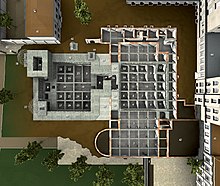
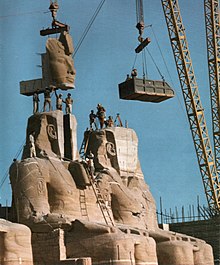
| start of building | completion | Surname | place | country |
|---|---|---|---|---|
| 1878 | 1879 | University of Giessen | to water | Germany |
| 1896 | 1897 | Rosental Viaduct | Friedberg | Germany |
| 1927 | 1932 | Zollverein colliery , Albert Vögler mine | eat | Germany |
| 1927 | 1928 | Predigtstuhlbahn | Bad Reichenhall | Germany |
| 1928 | 1929 | Echelsbacher Bridge | between Rottenbuch and Bayersoien | Germany |
| 1929 | 1931 | Schluchseedamm | Schluchsee | Germany |
| 1930 | 1934 | Albert Canal | Belgium | |
| 1938 | 1945 | Participation in the Nazi era: Westwall | St. Wendel (construction phase) | Germany |
| 1938 | 1945 | Participations in the Nazi era: Atlantic Wall | Fauske- Harvik (construction phase) | Norway |
| 1938 | 1945 | Participation in the Nazi era: Berghof | Obersalzberg | Germany |
| 1938 | 1945 | Participation in the Nazi era: Wolfsschanze | Gierłoż (Kętrzyn) | Poland |
| 1938 | 1945 | Participations in the Nazi era: Führerbunker | Berlin | Germany |
| 1938 | 1945 | Participation in the Nazi era: Seebad Prora | Binz | Germany |
| 1946 | 1949 | University Hospital Bonn | Bonn | Germany |
| 1952 | 1956 | Sariyar dam | Turkey | |
| 1954 | 1964 | Vianden pumped storage plant | Vianden | Luxembourg |
| 1958 | 1960 | Jülich nuclear research facility | Jülich | Germany |
| 1961 | 1963 | Hilton Hotel Athens | Athens | Greece |
| 1963 | 1968 | Relocation of the temples from Abu Simbel | Abu Simbel | Egypt |
| 1968 | 1972 | Frankfurt am Main airport | Frankfurt am Main | Germany |
| 1969 | 1975 | New Elbe tunnel | Hamburg | Germany |
| 1970 | 1973 | Bosphorus bridge | Istanbul | Turkey |
| 1974 | 1981 | King Abdulaziz International Airport | Jeddah | Saudi Arabia |
| 1983 | 1988 | Aalto Theater | eat | Germany |
| 1988 | 1991 | Exhibition tower | Frankfurt am Main | Germany |
| 1990 | 1992 | Frédéric Chopin Airport (Terminal 1) | Warsaw | Poland |
| 1994 | 1996 | Commerzbank Tower | Frankfurt am Main | Germany |
| 1996 | 2000 | Athens-Eleftherios Venizelos Airport | Athens | Greece |
| 1996 | 2000 | Oresund Bridge | Copenhagen / Malmö | Denmark / Sweden |
| 1998 | 2000 | Kandinsky-Klee Masters' House | Dessau | Germany |
| 2001 | 2016 | Gotthard Base Tunnel | Erstfeld / Bodio | Switzerland |
| 2002 | 2006 | Ngqura deep sea port | Port Elizabeth | South Africa |
| 2004 | 2006 | Westend Duo | Frankfurt am Main | Germany |
| 2005 | 2008 | Dnipro Stadium | Dnepropetrovsk | Ukraine |
| 2005 | 2007 | Container Terminal Gdansk | Danzig | Poland |
| 2006 | 2008 | Kranhaus Mitte | Cologne | Germany |
| 2007 | 2016 | Elbphilharmonie | Hamburg | Germany |
| 2007 | 2012 | Subway line U4 | Hamburg-HafenCity | Germany |
| 2007 | 2009 | Unilever House (HafenCity) | Hamburg | Germany |
| 2007 | 2011 | Kaiserschleuse | Bremerhaven | Germany |
| 2008 | 2009 | Modernization of the Fürst Wrede barracks | Munich | Germany |
| 2008 | 2010 | Hafenspitze Düsseldorf | Dusseldorf | Germany |
| 2008 | 2010 | Federal motorway A4 | Eisenach / Waltershausen | Germany |
| 2009 | 2012 | Berlin Ostkreuz train station | Berlin | Germany |
| 2010 | 2012 | Lanxess Tower (during the renovation the building was called maxCologne) | Cologne | Germany |
| 2011 | 2015 | A8 federal motorway | Ulm / Augsburg | Germany |
| 2012 | Global Tech I ( offshore wind farm ) | EEZ in the North Sea | Germany | |
| 2013 | Berlin City Palace / Humboldt Forum | Berlin | Germany | |
| 2014 | Expansion of the Riyadh airport | Riad | Saudi Arabia | |
| 2019 | Schwelmetalbrücke Autobahn A1 | Wuppertal | Germany | |
| 2020 | Neuenkamp bridge over the Rhine | Duisburg | Germany |
literature
- Manfred Pohl , Birgit Siekmann: Hochtief and its history. Piper-Verlag, Munich 2000, ISBN 3-492-04270-8 .
Web links
- Hochtief website
- Early documents and newspaper articles on Hochtief in the 20th Century press kit of the ZBW - Leibniz Information Center for Economics .
Individual evidence
- ↑ hochtief.de: history
- ↑ a b business figures
- ^ Engineering News Record: The Top 250 International Contractors. August 26, 2013. Retrieved August 30, 2013 .
- ↑ HOCHTIEF Investor Relations> HOCHTIEF share> Shareholder structure. Retrieved October 1, 2019 .
- ↑ Hochtief wants to increase profitability in the long term, reduce debt and reposition itself. (PDF; 147 kB) Hochtief, accessed on August 22, 2013 .
- ^ Towards the leading global infrastructure contractor with sustained profitable growth. (PDF; 1.5 MB) Hochtief, accessed on August 22, 2013 (English).
- ↑ strategy. Towards the future. With solutions from HOCHTIEF. Hochtief, accessed August 30, 2013 .
- ↑ a b c Positioning and range of services. Hochtief, accessed September 6, 2013 .
- ↑ Company portrait . Hochtief PPP Solutions, accessed February 11, 2016 .
- ↑ Energy infrastructure strategy
- ↑ a b Hochtief completes sale of its offshore assets. In: Hochtief press release of May 19, 2015.
- ↑ Manfred Pohl, Birgit Siekmann: Hochtief and his history, Piper Verlag, Munich 2000, ISBN 3-492-04270-8 , p. 19f.
- ↑ Manfred Pohl, Birgit Siekmann: Hochtief and his story, Piper Verlag, Munich 2000, ISBN 3-492-04270-8 , p. 22.
- ↑ Manfred Pohl, Birgit Siekmann: Hochtief und seine Geschichte, Piper Verlag, Munich 2000, ISBN 3-492-04270-8 , p. 92.
- ^ Berliner Unterwelten eV: Vorbunker and Führerbunker. Out: Forty steps under the reinforced concrete ceiling - that was left: Smashed wash basin in the bomb-proof 'Führerbunker'. (No longer available online.) In: Telegraph. November 25, 1947, archived from the original on August 18, 2013 ; accessed on August 23, 2013 . Info: The archive link was inserted automatically and has not yet been checked. Please check the original and archive link according to the instructions and then remove this notice.
- ↑ Responsibility for the company's history in the “Third Reich”. (PDF; 57 kB) Hochtief, accessed on August 22, 2013 .
- ↑ Manfred Pohl, Birgit Siekmann: Hochtief and his story. Piper Verlag, Munich 2000, ISBN 3-492-04270-8 , p. 267.
- ↑ Die Zeit: It is late for Abu Simbel. December 6, 1963, accessed September 6, 2013 .
- ↑ The rescue of Abu Simbel. Hochtief, accessed August 23, 2013 .
- ↑ Dirk Bitzer: Hochtief at the temple back. Retrieved August 23, 2013 .
- ^ Terence Spencer: The Race to Save Abu Simbel Is Won. In: Life . 2nd December 1966.
- ^ Actividades de Construcción y Servicios, SA: ACS press release. (PDF; 19 kB) (No longer available online.) September 16, 2010, archived from the original on December 19, 2013 ; Retrieved August 23, 2013 (Spanish). Info: The archive link was inserted automatically and has not yet been checked. Please check the original and archive link according to the instructions and then remove this notice.
- ↑ Michael Gassmann: German construction industry attacks BaFin. In: Financial Times Germany. November 30, 2010, archived from the original on January 31, 2011 ; accessed on January 16, 2014 .
- ↑ Qatar becomes a major shareholder in Hochtief. (No longer available online.) In: Frankfurter Rundschau. December 6, 2010; Archived from the original on January 1, 2012 ; accessed on August 23, 2013 .
- ↑ manager magazin online: ACS has achieved its goal. ak / rtr / dpa-afx, January 4, 2011, accessed on August 22, 2013 .
- ↑ ACS 'share of voting rights has exceeded the 50 percent threshold - Publication pursuant to Section 26 (1) WpHG. (PDF; 50 kB) Hochtief, June 17, 2011, accessed on February 11, 2016 .
- ↑ Dr. Herbert Lütkestratkötter will step down from the board on May 12, 2011 - Board member Dr. Frank Stieler's successor. Hochtief, April 10, 2011, accessed August 22, 2013 .
- ↑ Marcelino Fernández Verdes new CEO of Hochtief - Dr. Frank Stieler leaves the group. Hochtief, November 20, 2012, accessed August 22, 2013 .
- ↑ a b Hochtief: Hochtief wants to sustainably increase profitability, reduce debt and reposition itself. In: Hochtief press release. Hochtief Aktiengesellschaft, February 28, 2013, accessed on March 18, 2014 .
- ↑ Hochtief sells airport business to Canadian pension fund. Hochtief, May 7, 2013, accessed August 22, 2013 .
- ↑ Hochtief sells service division to Spie. Hochtief, June 28, 2010, accessed August 27, 2013 .
- ^ Christian Gerhardus: Hochtief sells its share in the real estate company aurelis. (PDF) Hochtief Aktiengesellschaft, Essen, February 3, 2014, accessed on March 10, 2014 .
- ↑ Zeppelin: Zeppelin Group takes over a large part of the Hochtief subsidiary Streif Baulogistik. (PDF) (No longer available online.) In: Zeppelin press release. Zeppelin, March 11, 2014, archived from the original on March 18, 2014 ; accessed on March 18, 2014 . Info: The archive link was inserted automatically and has not yet been checked. Please check the original and archive link according to the instructions and then remove this notice.
- ↑ Hochtief: Hochtief with a good first half-year - Group restructuring is going according to plan In: Hochtief press release. Hochtief Aktiengesellschaft, August 14, 2013, accessed on March 18, 2014 .
- ↑ Hochtief: Hochtief takes another step towards reorganizing its European business. In: Hochtief Solutions press release. Hochtief Solutions AG, January 9, 2014, accessed on March 18, 2014 .
- ↑ Michael Gassmann: Hochtief is still building. In: Article in Die Welt. Die Welt, February 28, 2014, accessed March 18, 2014 .
- ↑ Hochtief: Offer ended: Hochtief now holds 69.62 percent of Leighton. In: Hochtief press release. Hochtief Aktiengesellschaft, May 12, 2014, accessed May 19, 2014 .
- ^ Leighton: Improved Hochtief offer, Board and Management changes. (PDF) (No longer available online.) In: Leighton press release. Leighton Holdings Limited as of May 13, 2014, archived from the original on May 19, 2014 ; accessed on May 19, 2014 (English). Info: The archive link was inserted automatically and has not yet been checked. Please check the original and archive link according to the instructions and then remove this notice.
- ↑ The Hochtief structure. Hochtief, accessed August 22, 2013 .
- ↑ hochtief.de: Supervisory Board members
- ↑ Wuppertal: A1 bridge will be renovated from 2019. September 19, 2018, accessed September 5, 2019 .
Remarks
- ↑ A copy of the draft of the interest group agreement can be found in: Manfred Pohl, Birgit Siekmann: Hochtief und seine Geschichte. Piper-Verlag, Munich 2000, ISBN 3-492-04270-8 , pp. 84ff.






